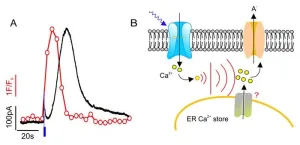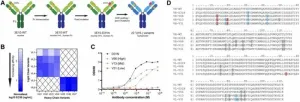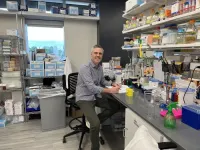(Press-News.org) When it comes to sustainable energy, harnessing nuclear fusion is—for many—a holy grail of sorts. Unlike climate-warming fossil fuels, fusion offers a clean, nearly limitless source of energy by combining light atomic nuclei to form heavier ones, releasing vast amounts of energy in the process.
But it isn’t easy replicating and controlling the process that powers the sun.
“We eventually want to move to producing energy this way,” says Brian Leard ’21 ’25G, a fifth-year PhD student in Lehigh University’s Department of Mechanical Engineering and Mechanics. “But you have to heat the plasma fuel to really, really high temperatures and densities, and then you have to confine it. That’s extremely difficult.”
As part of the legion of researchers around the world attempting to solve this and other problems associated with turning the vision of nuclear fusion into reality, Leard was recently recognized by the U.S. Department of Energy through its prestigious Office of Science Graduate Student Research program (SCGSR). According to the agency, “the program helps prepare doctoral candidates to enter jobs of critical importance to the DOE mission and secure the nation’s status at the forefront of discovery and innovation.” From a large, diverse, and highly competitive field of applicants, DOE selected just 62 students from 24 states to pursue their research at the agency’s national laboratories, and ultimately, contribute to addressing the country’s energy, environmental, and nuclear challenges.
Leard’s research project, “Toward Dual Plasma Equilibrium and Transport Optimization,” will be conducted at the DIII-D National Fusion Facility operated by General Atomics in San Diego.
The project focuses on optimizing the performance of tokamak reactors—devices designed to confine hot plasma (which serves as the fuel for generating nuclear reactions) using magnetic fields. The fusion fuel, typically isotopes of hydrogen like deuterium and tritium, must be heated to temperatures about seven times the temperature at the core of the Sun, necessitating precise control over various parameters to maintain stability and efficiency.
“When you’re trying to reach the conditions necessary to actually start generating energy, there are all sorts of actuators that drive aspects like current, torque, and heating, and change the shape of the plasma as well as its magnetohydrodynamic equilibrium and internal properties,” says Leard. “You have a target state for the plasma, but you don’t know the exact trajectories required by each of the actuators to achieve those conditions.”
Together with his team at Lehigh—which is led by Eugenio Schuster, a professor of mechanical engineering and mechanics in the P.C. Rossin College of Engineering and Applied Science and Leard’s advisor—the PhD student has developed a novel method that integrates advanced neural network models with plasma physics to develop simulation codes that can be used to optimize actuator operation. Such simulation has been done before, says Leard, but the codes currently in use often are very time consuming or neglect certain physical processes that can limit their scope and or accuracy.
“The simulation codes we have now capture a lot of the plasma physics, but they generally operate at timescales of hours to days,” he says. “The faster ones make significant assumptions that can impact the prediction accuracy. I’m trying to create a code that is both fast enough for optimization, and more accurate than those previously used.”
Leard and his team are integrating neural-network based surrogate models that are trained on high-fidelity codes that allow them to capture their prediction accuracy without being burdened by their computation time. They’ve also integrated an equilibrium code with a transport code so they can evolve the plasma shape along with the plasma internal profiles like temperature and density, both of which improves the accuracy of their code and allows them to do dual transport and shape optimization.
In San Diego, Leard will focus on conducting the optimizations with this improved simulation code by applying different optimization techniques and different couplings between the optimizer and the simulator.
Such a model could also potentially help reduce the costs of research conducted at tokamaks like DIII-D (a purely experimental machine meant to support the design and operation of future nuclear fusion production plants, like ITER in France)—and lead to new discoveries.
“Every discharge on a tokamak is hundreds of thousands of dollars,” he says. “If we’re able to come up with solutions—meaning the right combination of inputs to get to the desired state we’re looking for—by using a simulation code and an optimizer instead of experimentally, we could also potentially find improved paths toward advanced operating regimes. The algorithm could come up with solutions that we as humans hadn’t considered.”
The SCGSR award will support Leard’s work at the Southern California facility for approximately nine months. For Leard, it’s a unique opportunity to work with national lab researchers and get a feel for that particular career path. And while his work there will be computational, he’s excited about the proximity he’ll have to the DIII-D tokamak.
“I’ll be able to observe the experiments that others are running on the machine,” he says, “and get a better sense of the steps it would take to apply my own work in that way, because ultimately, running experiments is what I want to do.”
Leard was on an airplane, about to take off for a hard-earned vacation, when he found out he’d received the award. And while he says the win was unexpected, he knew he was applying from a position of strength, having Schuster’s guidance and his team’s support from the very beginning of his graduate experience. It was what he calls a “whole group effort.”
“I believe that nuclear fusion represents the future when it comes to our energy ecosystem, and it’s an honor to see that people are interested in my research,” he says. “It motivates me even more to try to solve some of these challenges.”
END
Lehigh student awarded highly selective DOE grant to conduct research at DIII-D National Fusion Facility
Brian Leard will work on developing faster, more accurate simulation models to drive nuclear fusion forward as one of only 62 students to receive the prestigious award through the Office of Science Graduate Student Research (SCGSR) program
2024-10-21
ELSE PRESS RELEASES FROM THIS DATE:
Plant guard cells can count environmental stimuli
2024-10-21
Plants control their water consumption via adjustable pores (stomata), which are formed from pairs of guard cells. They open their stomata when there is a sufficient water supply and enough light for carbon dioxide fixation through photosynthesis. In the dark and in the absence of water, however, they initiate the closing of the pores.
SLAC/SLAH-type anion channels in the guard cells are of central importance for the regulation of the stomata. This has been shown by the group of Professor Rainer Hedrich, biophysicist at Julius-Maximilians-Universität ...
UAMS researchers find ground beef packs bigger muscle-building punch than soy-based alternative
2024-10-21
When it comes to building muscle, not all proteins are created equal.
New research from the University of Arkansas for Medical Sciences (UAMS) reveals that 100% ground beef packs a bigger punch for muscle protein synthesis than a soy-based counterpart. In fact, the study suggests that a person would need double the amount of soy-based protein to achieve the same results.
Published in the American Journal of Clinical Nutrition, the study examined the anabolic response — how the body builds muscle — after consuming a 4-ounce beef patty versus one or two 4-ounce patties of a soy-based product. The results? Just one serving of beef did the ...
Study: AI could transform how hospitals produce quality reports
2024-10-21
A pilot study led by researchers at University of California San Diego School of Medicine found that advanced artificial intelligence (AI) could potentially lead to easier, faster and more efficient hospital quality reporting while retaining high accuracy, which could lead to enhanced health care delivery.
The study results, published in the October 21, 2024 online edition of the New England Journal of Medicine (NEJM) AI, found an AI system using large language models (LLMs) can accurately process hospital quality measures, ...
Four U-M faculty elected to National Academy of Medicine
2024-10-21
Four University of Michigan faculty have been elected to the National Academy of Medicine, one of the highest honors in medical research.
Kenneth M. Langa, M.D., Ph.D., Erica E. Marsh, M.D., MSCI, FACOG, Santa J. Ono, Ph.D. and Marc A. Zimmerman, Ph.D., are among 100 newly elected health and medical scientists recognized for their outstanding professional achievement and commitment to service.
They join the 79 other current, former and late U-M faculty who have earned this distinction. NAM members help the Congressionally chartered, private nonprofit organization provide objective advice to the nation on key health ...
FSU College of Medicine research team connects loneliness with heightened risk of dementia in largest study of its kind
2024-10-21
New research led by Florida State University College of Medicine faculty quantified the association between loneliness and dementia by analyzing data from more than 600,000 people around the world — the largest study of its kind.
The meta-analysis of 21 longitudinal studies showed that experiencing feelings of loneliness increased the risk of developing dementia by 31%. The research was published in Nature Mental Health.
“These results are not surprising, given the mounting evidence that link loneliness to poor health,” said Assistant Professor Martina Luchetti, who led the study. “Dementia ...
Berry studying nitrogen vacancy diamond metrology for temperature and pressure sensing
2024-10-21
Tyrus Berry, Assistant Professor, Mathematics, College of Science, received funding for the project: “Nitrogen Vacancy Diamond Metrology for Temperature and Pressure Sensing: Data Assimilation.”
Berry aims to provide the mathematical tools for a robust sensor that can simultaneously measure temperature, pressure, and force over a long range of values in harsh environments.
The sensor readings will be tied to fundamental physics laws, and the mathematical framework will automatically track any drift in the ...
Antil studying structure preserving optimization algorithms and digital twins
2024-10-21
Antil Studying Structure Preserving Optimization Algorithms & Digital Twins
Harbir Antil, Professor, Mathematical Sciences, College of Science, received funding from the National Science Foundation to study partial differential equation (PDE)-constrained optimization problems that incorporate data to make decisions in the presence of uncertainty arising from modeling unknown quantities.
The proposed methods support various application areas, including digital twins where physics and data are fused to support decision making.
One graduate student will be supported by the project and the ...
Yang developing integrated evaluation cyberinfrastructure towards safe a dependable autonomous driving systems
2024-10-21
Lishan Yang, Assistant Professor, Computer Science, College of Engineering and Computing (CEC), received funding for the project: “Collaborative Research: Elements: MELIOREM: An Integrated Evaluation Cyberinfrastructure towards Safe and Dependable Autonomous Driving Systems.”
Yang and her collaborators aim to develop MELIOREM, an automated tool designed to enhance the safety of autonomous vehicles.
MELIOREM will conduct rigorous testing to identify and address potential safety issues before they affect public roads. This initiative ensures that autonomous vehicles are dependable ...
Next-gen cell-penetrating antibodies for tumor targeting and RAD51 inhibition
2024-10-21
“Overall, the data presented in this study affirm that humanizing 3E10 preserves its crucial biological properties essential for therapeutic efficacy.”
BUFFALO, NY- October 21, 2024 – A new research paper was published in Oncotarget's Volume 15 on October 1, 2024, entitled, “Next-generation cell-penetrating antibodies for tumor targeting and RAD51 inhibition.”
As highlighted in the abstract, monoclonal antibody therapies for cancer have shown extraordinary clinical success in recent years. However, these strategies are primarily ...
New discovery could change autoimmune therapy landscape, study suggests
2024-10-21
Myasthenia gravis (MG) is a chronic autoimmune disorder in which antibodies block communication between nerves and muscle, resulting in weakness of the skeletal muscles. It can cause double vision, difficulty swallowing, and, occasionally, serious breathing difficulties, among other symptoms. Many autoimmune diseases such as MG, as well as a range of other human illnesses, result from the inability to regulate activity of IgG antibodies – collectively, these diseases are referred to as IgG-mediated pathologies.
In a paper out this month in Cell, researchers at Emory University have discovered a family of enzymes that ...
LAST 30 PRESS RELEASES:
Expanded school-based program linked to lower youth tobacco use rates in California
TV depictions of Hands-Only CPR are often misleading
What TV gets wrong about CPR—and why it matters for saving lives
New study: How weight loss benefits the health of your fat tissue
Astronomers surprised by mysterious shock wave around dead star
‘Death by a thousand cuts’: Young galaxy ran out of fuel as black hole choked off supplies
Glow with the flow: Implanted 'living skin' lights up to signal health changes
Compressed data technique enables pangenomics at scale
How brain waves shape our sense of self
Whole-genome sequencing may optimize PARP inhibitor use
Like alcohol units, but for cannabis – experts define safer limits
DNA testing of colorectal polyps improves insight into hereditary risks
Researchers uncover axonal protein synthesis defect in ALS
Why are men more likely to develop multiple myeloma than women?
Smartphone-based interventions show promise for reducing alcohol and cannabis use: New research
How do health care professionals determine eligibility for MAiD?
Microplastics detected in rural woodland
JULAC and Taylor & Francis sign open access agreement to boost the impact of Hong Kong research
Protecting older male athletes’ heart health
KAIST proposes AI-driven strategy to solve long-standing mystery of gene function
Eye for trouble: Automated counting for chromosome issues under the microscope
The vast majority of US rivers lack any protections from human activities, new research finds
Ultrasound-responsive in situ antigen "nanocatchers" open a new paradigm for personalized tumor immunotherapy
Environmental “superbugs” in our rivers and soils: new one health review warns of growing antimicrobial resistance crisis
Triple threat in greenhouse farming: how heavy metals, microplastics, and antibiotic resistance genes unite to challenge sustainable food production
Earthworms turn manure into a powerful tool against antibiotic resistance
AI turns water into an early warning network for hidden biological pollutants
Hidden hotspots on “green” plastics: biodegradable and conventional plastics shape very different antibiotic resistance risks in river microbiomes
Engineered biochar enzyme system clears toxic phenolic acids and restores pepper seed germination in continuous cropping soils
Retail therapy fail? Online shopping linked to stress, says study
[Press-News.org] Lehigh student awarded highly selective DOE grant to conduct research at DIII-D National Fusion FacilityBrian Leard will work on developing faster, more accurate simulation models to drive nuclear fusion forward as one of only 62 students to receive the prestigious award through the Office of Science Graduate Student Research (SCGSR) program




